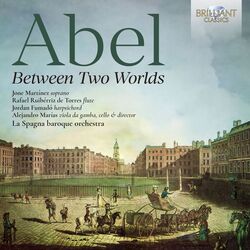Mit seiner Fähigkeit, ästhetische, künstlerische und soziale Veränderungen, die die Welt im 18. Jahrhundert umgestalteten, in seinen Werken zu veranschaulichen, gehört Carl Friedrich Abel (1723-1787) zu den interessanten Komponisten. Dennoch ist er fast vergessen. Als exquisiter Gambist war er sowohl als Solist wie auch kompositorisch für sein Instrument aktiv. Doch er bediente, vor allem in seinen Jahren in London, den galanten Stil und trug zur Entwicklung der Symphonie und des Streichquartetts als Form bei.
Die Aufnahmen, darunter Ersteinspielungen, geben einen Überblick über die verschiedenen Ausrichtungen seiner Musik für Orchester. Abels einziges nennenswertes Vokalwerk bietet die Arie Frena le belle lagrime aus der Pasticcio-Oper Sifari ein Beispiel für die Tendenz, obligate Instrumente in Opernarien zu verwenden.
Abels Werkkatalog enthält 420 Werke, davon 29 Konzerte für Soloinstrumente im italienischen Stil. Das Flötenkonzert ist mit drei in Moll stehenden Sätzen besonders. Das Konzert für Cembalo obligato spiegelt im ersten Satz mit charakteristischen Wechseln von Ritornellen und Soli den galanten Stil. Die Zuschreibung der beiden Gamben- bzw. Cellokonzerte des Albums ist nicht gesichert, aber auf Grund der Schreibweise Abel zurechenbar.
Das Album beginnt mit einer Symphonie als Beispiel für Abels Fähigkeit, für Orchester zu komponieren. Mit der Besetzung weist sie alle Merkmale der symphonischen Musik der Epoche auf.
Die Sopranistin Jone Martínez gibt mit ihrer einfachen geraden Gesangsweise der Arie ein charmantes Gepräge. Die Instrumentalsolisten Rafael Ruibérriz de Torres auf der Traversflöte sowie Jordan Fumadó am Cembalo erfüllen ihre Soloparts sicher mit musikalischem Atem. La Spagna spielt unangestrengt in allen Werken mit unbeschwertem und sicherem Zugriff, so dass sie den Kompositionen eine leicht verständliche Note sichern. Mit Alejandro Marías, der als Solist die Viola da Gamba und das Cello beherrscht und daneben auch die gesamte musikalische Leitung hat, steht ein engagierter Musiker für diese Musik bereit.
With his ability to illustrate in his works the aesthetic, artistic and social changes that reshaped the world in the 18th century, Carl Friedrich Abel is one of the most interesting composers. Yet he is almost forgotten. An exquisite gambist, he was active both as a soloist and as a composer for his instrument. However, especially during his years in London, he served the gallant style and contributed to the development of the symphony and the string quartet as a form.
The recordings, including premiere recordings, provide an overview of the various directions of his music for orchestra. Abel’s only vocal work worth mentioning is the aria Frena le belle lagrime from the opera pasticcio Sifari, an example of the tendency to use obbligato instruments in opera arias.
His catalog of works contains 420 works, 29 of which are concertos for solo instruments in the Italian style. The flute concerto is special with three movements in a minor key. The first movement of the concerto for harpsichord obligato reflects the galant style with its characteristic alternation of ritornellos and solos. The attribution of the two viola da gamba and cello concertos on the album is not certain, but can be attributed to Abel on the basis of the spelling.
The album begins with a symphony as an example of Abel’s ability to compose for orchestra. With its scoring, it has all the characteristics of symphonic music of the period.
The soprano Jone Martínez gives the aria a charming character with her simple, straightforward singing style. The instrumental soloists Rafael Ruibérriz de Torres on the transverse flute and Jordan Fumadó on the harpsichord fulfill their solo parts with musical breath. La Spagna plays effortlessly in all the works with a light-hearted and confident touch, ensuring that the compositions are easy to understand. Alejandro Marías, who plays the viola da gamba and cello as a soloist and is also responsible for the overall musical direction, is a committed musician for this music.


















